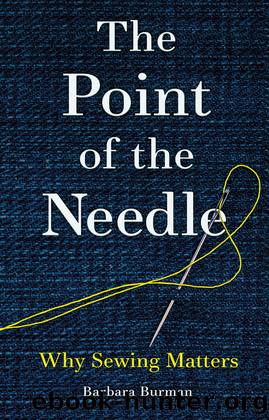The Point of the Needle by Barbara Burman

Author:Barbara Burman [Burman, Barbara]
Language: eng
Format: epub
ISBN: 9781789147193
Publisher: Reaktion Books
Published: 0101-01-01T00:00:00+00:00
6
The Business of the Needle
In rural Uganda, Georgina stations her sewing machine by her door at home to face the road. She bought the machine with a $55 loan from a financial empowerment initiative started by and for women in her village. Her business is mostly repairing childrenâs torn clothes and she earns $1.40 a day. When we think of those who sew for income, no two human stories are alike. In Georginaâs case, her machine work has brought her greater self-reliance and confidence with new ambitions to design and make clothes with local fabric for her community.1 Stitching as commerce, whether by individuals like Georgina or multinational clothing brands, presents a murky landscape with bad weather, but with sunny spots too. Exploited labour forces, opaque supply chains, fast fashion and environmental damage mark the lows. The highs are marked by imaginative designers, makers, legislators, sustainability certification organizations, campaigners, researchers, journalists, charities and projects like Georginaâs all pushing for positive change and those fashion brands which work with serious intent towards that end. Over a vast and varied landscape, the weather forecast is improving. Slowly.
All of us travel in one part or another of this landscape of making when we use the vast output made by people paid to stitch â our clothes, trainers, car seats, backpacks, even our catâs bed â to name just an infinitesimal fraction of what leaves factories and workrooms round the globe. Our dependence on the workers who sew them is incalculable. The focus in this chapter is on the people who make our garments in this labour-intensive manufacturing sector. People and planet are inseparable, and textiles and clothing together constitute one of the worldâs biggest industries with one of the largest environmental impacts. The tens of millions of people involved underline why we should know more and care about this largely invisible workforce.2 Everything about this industry, the first to globalize, is on a vast scale. Worldwide, 100 billion items of clothing are made annually, equating to 62 million metric tons of clothing, and if this pattern continues, by 2029 this will have risen to 102 million tons.3
Anyone who has made themselves a garment will understand that the workforce sewing these vast numbers of garments is doing skilled work that should be acknowledged as such. Jade Halbert, a UK academic, set out to make a dress for herself for the first time, a project that was âfunâ but also a steep learning curve in more ways than one.
Iâm more convinced now than ever before that making clothes is not, by any definition, low-skilled work. It is engineering with cloth and, from first cut to final stitch, it is a process that demands meticulous attention to detail and sustained concentration. The people who make our clothes, in factories, workrooms or living rooms, are deserving of our deepest admiration.4
But when the garments we buy for ourselves are made at a great distance, in unknown places, it surely contributes to disengagement from the processes and people involved. Out of sight, out of mind, and ethics can be undermined by distance.
Download
This site does not store any files on its server. We only index and link to content provided by other sites. Please contact the content providers to delete copyright contents if any and email us, we'll remove relevant links or contents immediately.
How to Embroider Almost Every Cute Thing by Nihon Vogue(422)
The Pocket Guide to Fishing Knots: A Step-by-Step Guide to the Most Important Knots for Fresh and Salt Water - PDFDrive.com by Joseph B. Healy(337)
Ultimate Book of Everyday Knots by Geoffrey Budworth(236)
Crochet Collage Garden by Chris Norrington(233)
280 Japanese Lace Stitches by Nihon Vogue(233)
100 Crochet Tiles by Various(227)
The Ultimate All-Around Stitch Dictionary by Bernard Wendy;(226)
vogue knitting beginner basics by Unknown(226)
Spooktacular Crochet by Annie's(219)
Adding Layers—Color, Design & Imagination by Kathy Doughty(204)
Crochet Your Own Kawaii Animal Cuties by Katalin Galusz(195)
Better Homes & Gardens Can It! by Unknown(193)
Christmas Amigurumi--5 Crochet Patterns by Sayjai Thawornsupacharoen(192)
Super Easy Crochet for Beginners by Burger Deborah;(188)
Satisfying Stitches by Hope Brasfield(183)
Traditional Knitting Patterns by James Norbury(182)
Crochet Wraps Every Which Way by Tammy Hildebrand(181)
Quick Crochet for Kitchen and Home by Salena Baca & DANYEL PINK & EMILY TRUMAN(176)
More Stunning Stitches for Crazy Quilts by Kathy Seaman Shaw(171)
